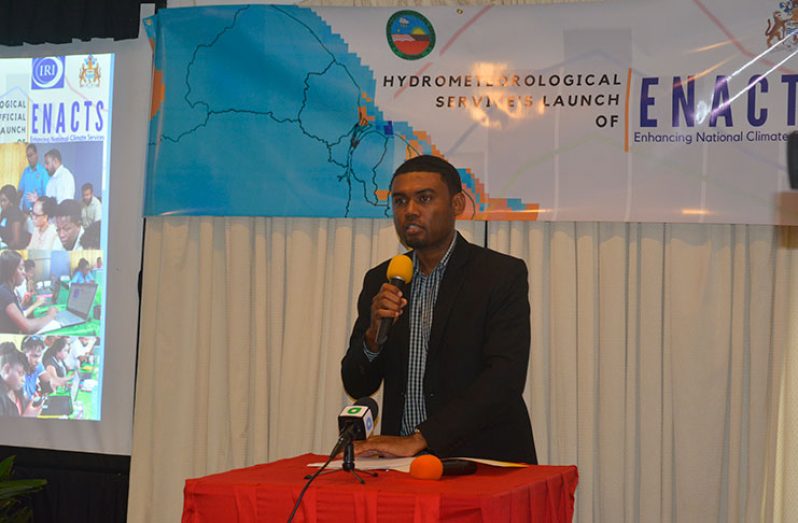IN an attempt to provide reliable and readily accessible climate data at high resolution to decision-makers across Guyana, the Hydromet Department launched its “Enhancing National Climate Services (ENACTS)” initiative on Thursday at the Herdmanston Lodge.
ENACTS is led by the International Research Institute for Climate and Society and is an exclusive, multi-faceted initiative designed to bring climate knowledge into national and regional decision-making by improving availability, access to, and use of climate information. ENACTS provides strong climate data, targeted information products and training that is relevant to user needs, enabling them to apply climate information to decision-making with confidence.
With ENACTS, users will be able to understand natural variability in temperature and precipitation over national, regional and district scales and assess the impacts on development outcomes. They will also comprehend climate sensitivity to map populations and systems at risk of climate variability and change.
In addition, users will be able to improve the timing and scale of climate-sensitive interventions and design early-warning systems.
Giving brief remarks at the event, Chief Hydromet Officer, Dr. Garvin Cummings, said that the event marked a significant milestone for Guyana in the provision of climate services. “The products and tools now being made available have the potential to improve the access to a wide array of climate information and will also, hopefully, boost public confidence in locally generated products from the hydromet service,” he noted.

According to Cummings, the quality of data that the Hydromet Department is now capable of providing suggests that there will be an improvement in the quality of products and services that they generate. He added that over the past months, significant work has been done in training the Hydromet Department’s staff to utilise the tools that are provided under the ENACTS initiative.
He noted that the Hydromet Department has been able to take steps to improve the ability, access to, and use of climate information and services, through the work that is being done under the initiative. “Over the past months, we have been able to control climate data, rainfall and temperature, from stations across the country and to merge quality ground data, satellite and [re-analyse] products to produce greater rainfalls and temperature data across Guyana,” Cummings explained.
Early this week, the Hydromet Department was able to expose a number of stakeholders to ENACTS and it is their hope that time they would have a large number of people utilizing the tools and products that are becoming available.
According to Cummings, the Hydromet Department hosted a National Consultation on climate services in 2015 which brought together representatives of key climate-sensitive sectors including agriculture, Public works, organisations involved in disaster reduction, the Guyana Energy Agency, the University of Guyana, the private sector and non-governmental organisations.
The main goal of the consultation was to identify gaps between the Climate Information and Services provided by Hydromet. The National Consultation on climate services aimed to facilitate the gaps between hydromet, the user organisations, the climate research community, decision makers and planners in key sectors, where decisions and practices need to be informed by Climate Services.
Cummings indicated that since the National Consultation four years ago, the Hydromet Service has been “taking steps in addressing the barriers which prevented the service from delivering under the bias of our stakeholders, but also, significant effort has been directed towards the provision of the basic services expected from a National Hydromet Service.”
He indicated that in order to address the gaps, Hydromet, with the support of national, regional and international partners, have invested in training staff in numerous areas, including weather forecasting, water resources management and hydrological forecasting, hydro geology, water quality monitoring, public communications, seasonal forecasting and the provision of climate services.



.jpg)








